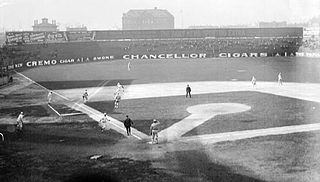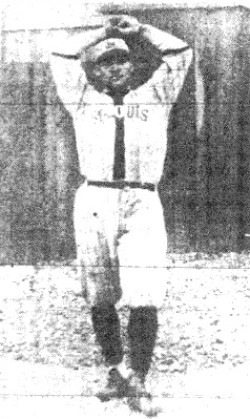Related Research Articles

The Mutual Association of Eastern Colored Clubs, more commonly known as the Eastern Colored League (ECL), was one of the several Negro leagues, which operated during the time organized baseball was segregated.

National League Park, commonly referred to as the Baker Bowl after 1923, was a baseball stadium home to the Philadelphia Phillies from 1887 until 1938, and the first home field of the Philadelphia Eagles from 1933 to 1935. It opened in 1887 with a capacity of 12,500. It burned down in 1894 and was rebuilt in 1895 as the first ballpark constructed primarily of steel and brick and with a cantilevered upper deck.

South Side Park was the name used for three different baseball parks that formerly stood in Chicago, Illinois, at different times, and whose sites were all just a few blocks away from each other.

Washington Park was the name given to three Major League Baseball parks on two different sites in the Park Slope neighborhood of Brooklyn, New York, located at the intersection of Third Street and Fourth Avenue. The two sites were diagonally opposite each other, on the southeast and northwest corners.

Nicollet Park was a baseball ground located in Minneapolis, Minnesota, United States. The venue was home to the minor league Minneapolis Millers of the Western League and later American Association from 1896 to 1955.

Ridgewood Park, also known as Wallace's Ridgewood Park or the Wallace Grounds, and frequently confused with Grauer's Ridgewood Park, was a baseball ground in Ridgewood, Queens, New York. Both Wallace's and Grauer's are shown in Belcher Hyde's Map of Newtown in 1915. The baseball field was part of a larger entertainment area bounded Wyckoff Avenue, Covert Street, Halsey Street, and Irving Avenue. The baseball field was southwest of the Long Island Rail Road's Montauk Branch tracks. Eldert Street, although depicted on the map as running through the baseball grounds, was not cut through southwest of the railroad tracks and the road remains interrupted there today. Originally the park was in Queens County, before its incorporation into New York City in 1899. This facilitated Sunday baseball playing, including the charging of admission, beyond the reach of Sabbath enforcers from the then-city of Brooklyn.

Sulphur Dell, formerly known as Sulphur Spring Park and Athletic Park, was a baseball park in Nashville, Tennessee, United States. It was located just north of the Tennessee State Capitol building in the block bounded by modern-day Jackson Street, Fourth Avenue North, Harrison Street, and Fifth Avenue North. The ballpark was home to the city's minor league baseball teams from 1885 to 1963. The facility was demolished in 1969.
The Chicago American Giants were a Chicago-based Negro league baseball team. From 1910 until the mid-1930s, the American Giants were the most dominant team in black baseball. Owned and managed from 1911 to 1926 by player-manager Andrew "Rube" Foster, they were charter members of Foster's Negro National League. The American Giants won five pennants in that league, along with another pennant in the 1932 Negro Southern League and a second-half championship in Gus Greenlee's Negro National League in 1934.

Pelican Stadium, originally known as Heinemann Park (1915–1937), was a sports stadium in New Orleans, Louisiana from 1915 to 1957.

The Hilldale Athletic Club were an American professional Negro league baseball team based in Darby, Pennsylvania, west of Philadelphia.
Russwood Park was a stadium in Memphis, Tennessee. It was primarily used for baseball and was the home of the Memphis Chicks, the Negro American League Memphis Red Sox, and the Memphis Red Sox minor league baseball team until the spring of 1960. The ballpark was originally built in 1896 and was known as Elm Wood Park or Red Elm Park. In 1915, team owner Russell E. Garner incorporated his name into the ballpark's name. The "wood" part of the name would figure into its demise.
The P.R.R. YMCA Athletic Field, also known as Penmar Park and commonly referred to in the 1930s and 1940s as the 44th and Parkside ballpark, was an athletic field and ballpark in West Philadelphia from as early as the 1890s to the early 1950s. It was built by the Pennsylvania Railroad YMCA for use by its employees. Behind the right-field fence stood the roundhouse of the main yard of the Pennsylvania Railroad. The Negro league baseball Philadelphia Stars played home games at the park from 1936 until 1952.
Indianapolis Park or Athletic Park (II) was a baseball ground in Indianapolis, Indiana. It was the Sunday home field of the Indianapolis Hoosiers baseball club of the National League from 1888 to 1889.

Luther Alaner Farrell, nicknamed "Red", was an American baseball pitcher in the Negro leagues. He played from 1919 to 1934 with several teams, playing mostly for the Bacharach Giants.
Dyckman Oval was a sports venue in the Inwood neighborhood of Upper Manhattan in New York City. It was most commonly known as a home for Negro league baseball, but was frequently used for other events, including boxing, cricket, wrestling, football, soccer, amateur baseball, and even ice skating competitions. It existed from about 1915 through 1937.
References
- 1 2 3 4 5 6 Lowry, Philip J (2019). Green Cathedrals: The Ultimate Celebration of All Major League and Negro League Ballparks (5th ed.). Phoenix, AZ: Society for American Baseball Research. pp. 51–53.
- ↑ Holway, John B. (2001), The Complete Book of Baseball's Negro Leagues: The Other Half of Baseball History, Fern Park, FL: Hastings House Publishers, pp. 216–218, 228–230, ISBN 0803820070
- ↑ 1922 Season Independent Clubs, Seamheads.com Negro Leagues Database